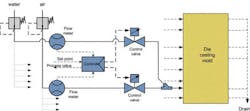Universal Controller, Advances in Measurement Manage Cooling to Improve Diecasting Quality
The product quality demands of automakers require diecasters to adopt increasingly stringent compliance standards for their finished products. Ultimately, this means they must have greater control over the temperature of their diecasting tooling. All processes must be reproducible and traceable. In addition, the cooling system must be capable of modular expansion, even with the smallest possible dimensions.
Bürkert Fluid Control Systems introduced a modular valve and sensor technology at GIFA 2011, one that it maintains will improve quality and process efficiency in diecasting operations. The new universal controller, the eCONTROL 8611, was developed for cooling systems to meet the increasing number of requirements, so that demanding cooling systems can be tailored to the requirements of any particular process.
Automated diecasting processes make it possible for manufacturers to produce high volumes of precision parts — specifically, thin-walled diecastings with very fine tolerances, smooth surfaces, and well-defined contours. Computer-controlled diecasting machines with automatic temperature control of the tooling ensure the production process is reproducible, so consistently high quality is possible for all finished products parts, even in high-volume production.
Mold temperature control is critical for maintaining the pressure in the chamber during cooling. Temperature channels just below the surface of the die cavity dissipate the heat effectively, and ensure relatively even temperatures in the mold. The shape of the workpiece and the heat transfer fluid determine the design of the cooling channels and the maximum possible mold temperature. If it’s necessary to dissipate large amounts of heat quickly, water or a water/air mixture is the preferred coolant (see Figure 1.)
The number, design and arrangement of the cooling channels in a diecasting mold are important for successful temperature regulation. Specifically, numerous small channels will achieve more precise temperature control than a few large holes. Standard diecasting systems generally provide five to 30 cooling channels for each mold, but there are designs with up to 100 cooling channels. However, the temperature of the coolant and the flow rate are critical for precise and reliable temperature control.
Several independent and parallel cooling circuits ensure more precise control of the cooling process, which improves the quality of the diecast parts. The recent development of proportional solenoid valves makes it possible to apply multi-loop parallel-working flow rate regulation circuits. The advantage lies in the frictionless bearing of the magnetic core ensured by specially formed springs that avoid stick-slip effects. This is demonstrated in excellent results with exceptional response sensitivity (0.1% of the final value), minimal reversal errors and excellent regulation performance.
The measuring range of these new proportional solenoid valves is 1:100, which makes it possible to initiate corrective action by adjusting the valves for even slight fluctuations in the flow rate. In combination with the new ultrasonic flow rate sensor, which has a measuring range of 1:200 and starts measuring at 0.06 l/min., it is possible to dose very small and precise flow rates to air flows (see Figure 2.)
Innovative, modular valve bodies eliminate the need for conventional connections between the single valves (see Figure 3.) The fluid connections are achieved by joining of the valve bodies, which results in a very compact design and robust valve systems for cooling of diecasting tools. Because inlet and outlet planes are separate in the new valve bodies, there is very little redirection of the fluid flow, compared to standard valve designs. As a result, the new valves also optimize the kv value. The modular design also makes it possible to produce small batches cost-effectively. The applications range from single valve solutions to complete control cabinet systems, according to Bürkert.
Special controllers are necessary for adjusting the quantity of coolant or air/ water mixture, for example to achieve an exact ratio of air to water. Bürkert also offers all actuators, sensors and controllers necessary for decentralized temperature control of the diecasting mold, which makes it possible to control specific machines. Decentralized temperature control of the mold also can be retrofitted to existing diecasting operations, easily and quickly.
